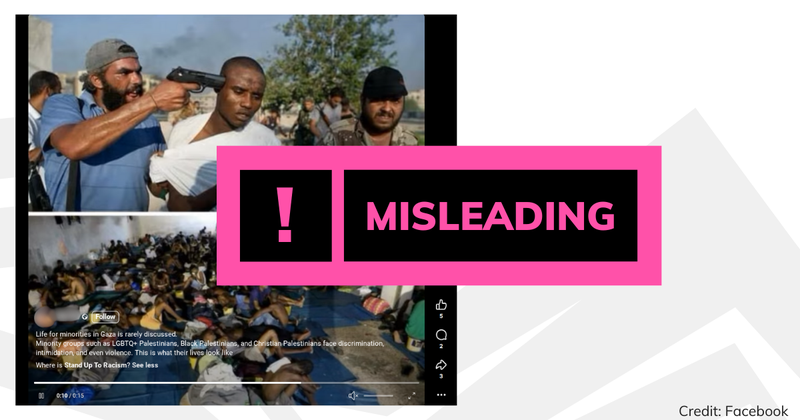What was claimed
Pictures show what life looks like for “minorities in Gaza”.
Our verdict
This is misleading. These images were taken in Libya, years earlier.
What was claimed
Pictures show what life looks like for “minorities in Gaza”.
Our verdict
This is misleading. These images were taken in Libya, years earlier.
Pictures being shared on social media alongside claims about “life for minorities in Gaza” were actually taken in Libya.

The first image shows a black man being held at gunpoint, while another shows a large group of people lying and sitting on the ground of a barely furnished room.
The images have been shared with the caption: “Life for minorities in Gaza is rarely discussed. Minority groups such as LGBTQ+ Palestinians, Black Palestinians, and Christian Palestinians face discrimination, intimidation, and even violence. This is what their lives look like.”
Join 72,953 people who trust us to check the facts
Sign up to get weekly updates on politics, immigration, health and more.
Subscribe to weekly email newsletters from Full Fact for updates on politics, immigration, health and more. Our fact checks are free to read but not to produce, so you will also get occasional emails about fundraising and other ways you can help. You can unsubscribe at any time. For more information about how we use your data see our Privacy Policy.
Full Fact traced the first image to Tripoli, in Libya, in August 2011. The image is captioned: “Rebels fighters in Abu Slim neighborhood against the last resistance of the Gadaffi loyalist forces”.
We also traced the second image to Tripoli, this time showing migrants at the “Anti-Illegal Immigration Authority” in September 2017.
It is difficult to find accurate and reliable information about the treatment of minority groups in Gaza, and so we have not looked at these claims in detail for this fact check.
But - to give a little background information - according to the Palestinian Central Bureau of statistics (PCBS) census, in 2017 there were around 47,000 Christians in Gaza and the West Bank, compared to more than 4.6 million Muslims. The vast majority of Christians were situated in the West Bank, with just over two per cent in Gaza.
Same-sex sexual activity is prohibited in Gaza under the British Mandate Criminal Code Ordinance 1936. The law was inherited from the British and continues to be in operation in Gaza. It carries a maximum penalty of 10 years’ imprisonment. Only men are criminalised under this law.
Consensual same-sex relationships are not criminalised in the West Bank, however.
Before sharing videos and images that you see on social media, consider whether it comes from a verifiable and trustworthy source. Our guides to spotting misleading images and videos can help you do this.
This article is part of our work fact checking potentially false pictures, videos and stories on Facebook. You can read more about this—and find out how to report Facebook content—here. For the purposes of that scheme, we’ve rated this claim as missing context because these pictures were taken in Libya, not Gaza.
Full Fact fights for good, reliable information in the media, online, and in politics.
Bad information ruins lives. It promotes hate, damages people’s health, and hurts democracy. You deserve better.
Subscribe to weekly email newsletters from Full Fact for updates on politics, immigration, health and more. Our fact checks are free to read but not to produce, so you will also get occasional emails about fundraising and other ways you can help. You can unsubscribe at any time. For more information about how we use your data see our Privacy Policy.